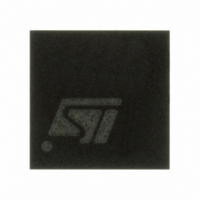ST7FLITE39F2U6 STMicroelectronics, ST7FLITE39F2U6 Datasheet - Page 82

ST7FLITE39F2U6
Manufacturer Part Number
ST7FLITE39F2U6
Description
IC MCU 8BIT 8K FLASH 20QFN
Manufacturer
STMicroelectronics
Series
ST7r
Datasheet
1.ST7FLITE35F2M6TR.pdf
(173 pages)
Specifications of ST7FLITE39F2U6
Core Processor
ST7
Core Size
8-Bit
Speed
16MHz
Connectivity
LINSCI, SPI
Peripherals
LVD, POR, PWM, WDT
Number Of I /o
15
Program Memory Size
8KB (8K x 8)
Program Memory Type
FLASH
Eeprom Size
256 x 8
Ram Size
384 x 8
Voltage - Supply (vcc/vdd)
2.7 V ~ 5.5 V
Data Converters
A/D 7x10b
Oscillator Type
Internal
Operating Temperature
-40°C ~ 85°C
Package / Case
20-QFN
For Use With
497-8406 - BOARD STF20NM50FD/STF7LITE39BF2497-8403 - BOARD DEMO STCC08 AC SW DETECTOR497-6398 - BOARD EVAL ST7FLITE39/STM1403497-5858 - EVAL BOARD PLAYBACK ST7FLITE497-5514 - EVAL BOARD THERMO CONTROL REFRIG497-5049 - KIT STARTER RAISONANCE ST7FLITE
Lead Free Status / RoHS Status
Lead free / RoHS Compliant
Other names
497-5635
Available stocks
Company
Part Number
Manufacturer
Quantity
Price
ST7LITE3xF2
SERIAL PERIPHERAL INTERFACE (cont’d)
11.4.3.3 Master Mode Operation
In master mode, the serial clock is output on the
SCK pin. The clock frequency, polarity and phase
are configured by software (refer to the description
of the SPICSR register).
Note: The idle state of SCK must correspond to
the polarity selected in the SPICSR register (by
pulling up SCK if CPOL = 1 or pulling down SCK if
CPOL = 0).
How to operate the SPI in master mode
To operate the SPI in master mode, perform the
following steps in order:
1. Write to the SPICR register:
2. Write to the SPICSR register:
3. Write to the SPICR register:
Important note: if the SPICSR register is not writ-
ten first, the SPICR register setting (MSTR bit)
may be not taken into account.
The transmit sequence begins when software
writes a byte in the SPIDR register.
11.4.3.4 Master Mode Transmit Sequence
When software writes to the SPIDR register, the
data byte is loaded into the 8-bit shift register and
then shifted out serially to the MOSI pin most sig-
nificant bit first.
When data transfer is complete:
Clearing the SPIF bit is performed by the following
software sequence:
1. An access to the SPICSR register while the
2. A read to the SPIDR register
82/173
1
– Select the clock frequency by configuring the
– Select the clock polarity and clock phase by
– Either set the SSM bit and set the SSI bit or
– Set the MSTR and SPE bits
– The SPIF bit is set by hardware.
– An interrupt request is generated if the SPIE
SPIF bit is set
SPR[2:0] bits.
configuring the CPOL and CPHA bits.
52
Note: The slave must have the same CPOL
and CPHA settings as the master.
clear the SSM bit and tie the SS pin high for
the complete byte transmit sequence.
Note: MSTR and SPE bits remain set only if
SS is high).
bit is set and the interrupt mask in the CCR
register is cleared.
shows the four possible configurations.
Figure
Note: While the SPIF bit is set, all writes to the
SPIDR register are inhibited until the SPICSR reg-
ister is read.
11.4.3.5 Slave Mode Operation
In slave mode, the serial clock is received on the
SCK pin from the master device.
To operate the SPI in slave mode:
1. Write to the SPICSR register to perform the fol-
2. Write to the SPICR register to clear the MSTR
11.4.3.6 Slave Mode Transmit Sequence
When software writes to the SPIDR register, the
data byte is loaded into the 8-bit shift register and
then shifted out serially to the MISO pin most sig-
nificant bit first.
The transmit sequence begins when the slave de-
vice receives the clock signal and the most signifi-
cant bit of the data on its MOSI pin.
When data transfer is complete:
Clearing the SPIF bit is performed by the following
software sequence:
1. An access to the SPICSR register while the
2. A write or a read to the SPIDR register
Notes: While the SPIF bit is set, all writes to the
SPIDR register are inhibited until the SPICSR reg-
ister is read.
The SPIF bit can be cleared during a second
transmission; however, it must be cleared before
the second SPIF bit in order to prevent an Overrun
condition (see
lowing actions:
– Select the clock polarity and clock phase by
– Manage the SS pin as described in
bit and set the SPE bit to enable the SPI I/O
functions.
– The SPIF bit is set by hardware.
– An interrupt request is generated if SPIE bit is
SPIF bit is set
configuring the CPOL and CPHA bits (see
Figure
Note: The slave must have the same CPOL
and CPHA settings as the master.
11.4.3.2
be held low continuously. If CPHA = 0 SS
must be held low during byte transmission and
pulled up between each byte to let the slave
write in the shift register.
set and interrupt mask in the CCR register is
cleared.
52).
and
Section
Figure
11.4.5.2).
50. If CPHA = 1 SS must
Section














